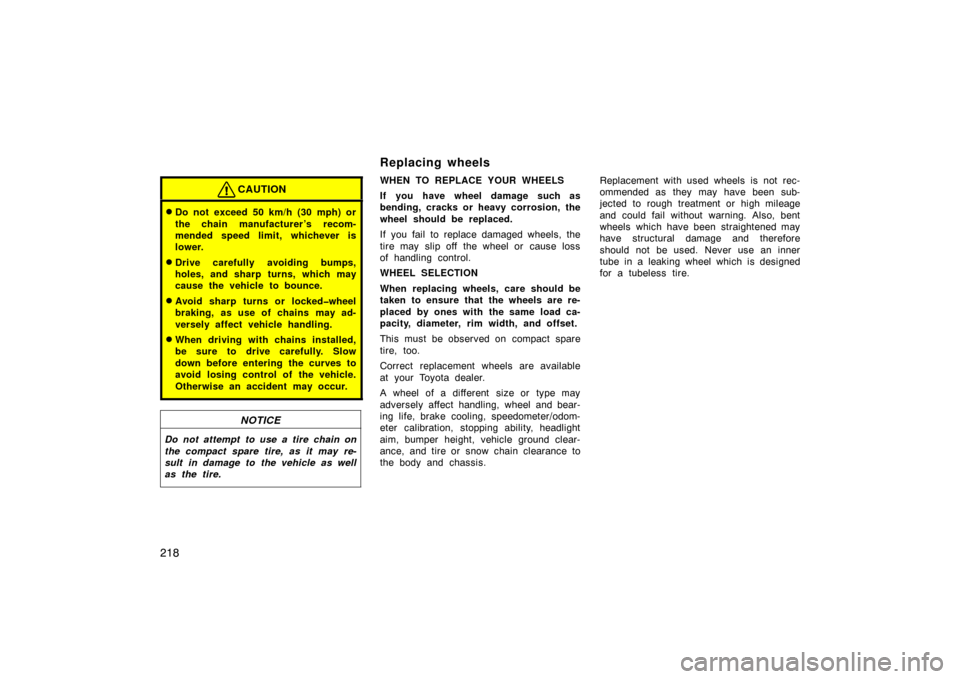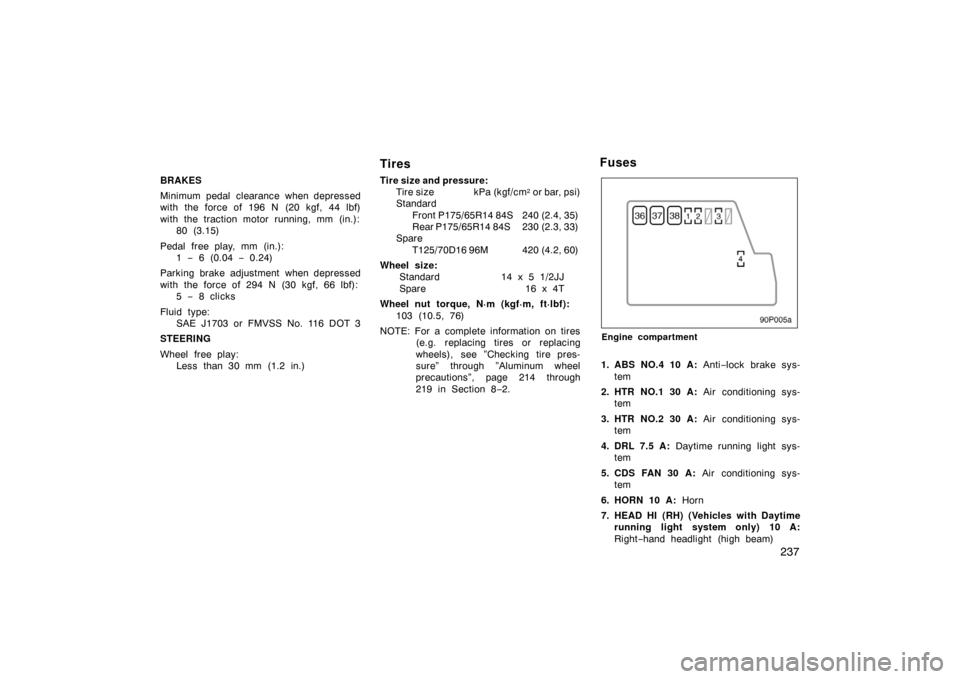Page 231 of 258

218
CAUTION
�Do not exceed 50 km/h (30 mph) or
the chain manufacturer ’s recom-
mended speed limit, whichever is
lower.
�Drive carefully avoiding bumps,
holes, and sharp turns, which may
cause the vehicle to bounce.
�Avoid sharp turns or locked�wheel
braking, as use of chains may ad-
versely affect vehicle handling.
�When driving with chains installed,
be sure to drive carefully. Slow
down before entering the curves to
avoid losing control of the vehicle.
Otherwise an accident may occur.
NOTICE
Do not attempt to use a tire chain on
the compact spare tire, as it may re-
sult in damage to the vehicle as well
as the tire.
WHEN TO REPLACE YOUR WHEELS
If you have wheel damage such as
bending, cracks or heavy corrosion, the
wheel should be replaced.
If you fail to replace damaged wheels, the
tire may slip off the wheel or cause loss
of handling control.
WHEEL SELECTION
When replacing wheels, care should be
taken to ensure that the wheels are re-
placed by ones with the same load ca-
pacity, diameter, rim width, and offset.
This must be observed on compact spare
tire, too.
Correct replacement wheels are available
at your Toyota dealer.
A wheel of a different size or type may
adversely affect handling, wheel and bear-
ing life, brake cooling, speedometer/odom-
eter calibration, stopping ability, headlight
aim, bumper height, vehicle ground clear-
ance, and tire or snow chain clearance to
the body and chassis.Replacement with used wheels is not rec-
ommended as they may have been sub-
jected to rough treatment or high mileage
and could fail without warning. Also, bent
wheels which have been straightened may
have structural damage and therefore
should not be used. Never use an inner
tube in a leaking wheel which is designed
for a tubeless tire.
Replacing wheels
Page 232 of 258
219
�
When installing aluminum w
heels,
check that the wheel nuts are tight
after driving your vehicle the first 1600
km (1000 miles).
�If you have rotated, repaired, or
changed your tires, check that the
wheel nuts are still tight after driving
1600 km (1000 miles).
�When using tire chains, be careful not
to damage the aluminum wheels.
�Use only the Toyota wheel nuts and
wrench designed for your aluminum
wheels.
�When balancing your wheels, use only
Toyota balance weights or equivalent
and a plastic or rubber hammer.
�As with any wheel, periodically check
your aluminum wheels for damage. If
damaged, replace immediately.
Aluminum wheel precautions
Page 247 of 258
234
Overall length mm (in.) 4305 (169.5)
Overall width mm (in.) 1695 (66.7)
Overall height mm (in.) 1465 (57.6)*
Wheelbase mm (in.) 2550 (100.4)
Front tread mm (in.) 1475 (58.1)
Rear tread mm (in.) 1480 (58.2)
Vehicle capacity weight
(occupants + luggage)kg (lb.) 363 (800)
*: Unladen vehicle
Electric motor
Type: Permanent magnet motor (water cooling)
Rated output: 20 kW
Maximum output: 33.0/1040 − 5600 kW/rpm
Maximum torque: 350.0/0 − 400 N·m/rpm Model: 1NZ
−FXE
Type: 4 −cylinder in line, 4 cycle, gasoline
Bore and stroke, mm (in.): 75.0 x 84.7 (2.95 x 3.33)
Displacement, cm
3 (cu. in.):
1497 (91.4)
Dimensions and weight Engine
Page 250 of 258

237
BRAKES
Minimum pedal clearance when depressed
with the force of 196 N (20 kgf, 44 lbf)
with the traction motor running, mm (in.):80 (3.15)
Pedal free play, mm (in.): 1 − 6 (0.04 − 0.24)
Parking brake adjustment when depressed
with the force of 294 N (30 kgf, 66 lbf): 5 − 8 clicks
Fluid type: SAE J1703 or FMVSS No. 116 DOT 3
STEERING
Wheel free play: Less than 30 mm (1.2 in.)
Tires
Tire size and pressure:Tire size kPa (kgf/cm2 or bar, psi)
Standard
Front P175/65R14 84S 240 (2.4, 35)
Rear
P175/65R14 84S 230 (2.3, 33)
Spare
T125/70D16 96M 420 (4.2, 60)
Wheel size: Standard 14 x 5 1/2JJ
Spare 16 x 4T
Wheel nut torque, N·m (kgf·m, ft·lbf): 103 (10.5, 76)
NOTE: For a complete information on tires (e.g. replacing tires or replacing
wheels), see ”Checking tire pres-
sure” through ”Aluminum wheel
precautions”, page 214 through
219 in Section 8 −2.
90p005a
Engine compartment
1. ABS NO.4 10 A: Anti−lock brake sys-
tem
2. HTR NO.1 30 A: Air conditioning sys-
tem
3. HTR NO.2 30 A: Air conditioning sys-
tem
4. DRL 7.5 A: Daytime running light sys-
tem
5. CDS FAN 30 A: Air conditioning sys-
tem
6. HORN 10 A: Horn
7. HEAD HI (RH) (Vehicles with Daytime running light system only) 10 A:
Right −hand headlight (high beam)
Fuses
Page 256 of 258

243
Tread wear—The tread wear grade is a
comparative rating based on the wear rate
of the tire when tested under controlled
conditions on a specified government test
course. For example, a tire graded 150
would wear one and a half (1 −1/2) times
as well on the government course as a
tire graded 100. The relative performance
of tires depends upon the actual condi-
tions of their use, however, and may de-
part significantly from the norm due to
variations in driving habits, service prac-
tices and differences in road characteris-
tics and climate.
Traction AA, A, B, C— The traction
grades, from highest to lowest, are AA, A,
B, and C, and they represent the tire’s
ability to stop on wet pavement as mea-
sured under controlled conditions on spe-
cified government test surfaces of asphalt
and concrete. A tire marked C may have
poor traction performance.
Warning: The traction grade assigned to
this tire is based on braking (straight
ahead) traction tests and does not include
cornering (turning) traction. Temperature A, B, C—
The temperature
grades are A (the highest), B, and C,
representing the tire’s resistance to the
generation of heat and its ability to dissi-
pate heat when tested under controlled
conditions on a specified indoor laboratory
test wheel. Sustained high temperature
can cause the material of the tire to de-
generate and reduce tire life, and exces-
sive temperature can lead to sudden tire
failure. The grade C corresponds to a lev-
el of performance which all passenger car
tires must meet under the Federal Motor
Vehicle Safety Standard No. 109. Grades
B and A represent higher levels of perfor-
mance on the laboratory test wheel than
the minimum required by law.
Warning: The temperature grades for this
tire are established for a tire that is prop-
erly inflated and not overloaded. Exces-
sive speed, underinflation, or excessive
loading, either separately or in combina-
tion, can cause heat buildup and possible
tire failure.